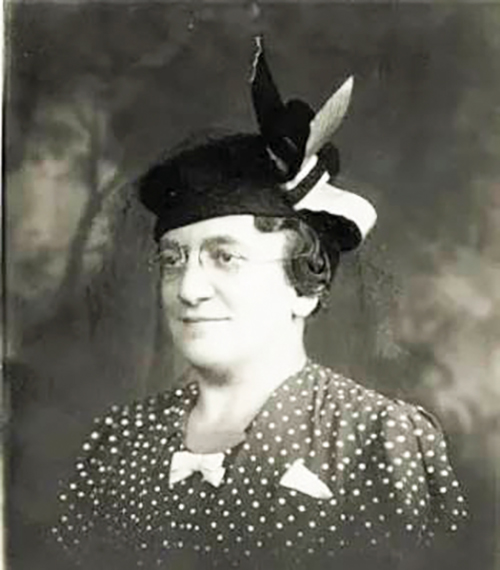
The next time you are in the supermarket shopping for kosher products — and looking for the OU label or other kosher certification — you might want to thank Rebbetzin Rebecca Goldstein, the individual who is most responsible for the growth of the kashrut industry in America.
Rebecca “Betty” Goldstein, the daughter of noted Jewish philanthropist Harry Fischel, founded the Women’s Branch of the OU in 1923 with a mission “to re-establish the Jewish home as a sanctuary and to recreate the Jewish mother as the priestess.” The OU’s Women’s Branch distributed pamphlets explaining women’s ritual obligations and argued that keeping kosher was the key to developing a spiritually and physically healthy Jewish home. They also published popular kosher cookbooks that made keeping kosher more attractive.
While attending Barnard College, Rebecca met Rabbi Herbert Goldstein, one of the most prominent 20th century Orthodox rabbis in America, who was studying at Columbia University at the time. After graduating in 1912, she continued her studies at the Teachers Institute of the Jewish Theological Seminary. She married Rabbi Goldstein in 1915.
Her interest in advancing kashrut reportedly began during her courtship with her future husband. When he took her out on a date, they found nothing to eat except milk, bananas, chestnuts and tomatoes.
Another motivating incident was a 1923 cruise with her father to what was then Palestine. Harry Fischel succeeded in convincing the caterer of the ocean liner company to allow for a separate kosher kitchen with new cooking utensils, a Jewish cook and a Jewish waiter for his family. Goldstein took note of the hardships other kosher travelers had to endure.
Shortly after she founded the OU’s Women’s Branch in 1923, Goldstein recognized the urgent need to increase the variety of food products available to the women whom they were urging to keep kosher. She appointed a kosher committee, which was charged with the mission of “making kosher products available to the housewife, products which had heretofore been of doubtful manufacture.” The Women’s Branch began dispatching representatives to personally inspect food manufacturing plants.
A member of the committee explained its objective this way: “We had always been telling our children what they might not eat. We decided to see if we could persuade some of the well-known manufacturers of food products to substitute kosher for non-kosher ingredients — and then we could point out the things we were permitted to eat.”
At that time, there was no system in place for kashrut and there were no standards. Individual rabbis were paid by food manufacturers to provide kosher certification, which often led to accusations of conflicts of interest and corruption.
Rebbetzin Goldstein’s efforts inspired her husband, who was president of the OU, to launch the organization’s first effort at kosher supervision. The OU certification program was to be “a not-for-profit public service free of the element of personal gain and vestment.” In addition, the new effort was aimed at ensuring the growth and vibrancy of Orthodox shuls, another important part of the OU mandate.
Goldstein, along with other members of the OU Women’s Branch, worked tirelessly to pressure food companies to make their products kosher. They gradually convinced a growing number of companies that catering to kosher consumers would increase sales.
By the mid-1930s, about two dozen companies, a few of which manufactured national brands, were OU Kosher certified. Two of the earliest products to receive kosher certification were Sunshine crackers and Heinz products.
One of the most popular items that received the OU seal of approval was Borden cream cheese, which was also certified as kosher for Passover. In a letter to the company the OU “promised the Borden Company that in recognition of their willingness to provide kosher cream cheese, we will do everything in our power to make this kosher cream cheese popular among our people.”
In 1935, when Loft’s — the world’s largest candy manufacturer at the time — became OU-certified, one publication announced that this was “an historic event for the Jews of America.” The occasion was marked with a dinner celebration at the Hotel Biltmore, at which the OU honored the non-Jewish president of Loft’s.
Goldstein not only worked to expand the range of kosher products nationally. She was also deeply committed to educating Jewish women about kashrut. Goldstein was instrumental in organizing synagogue sisterhood groups, which explained to women (many of whom did not have access to a formal Jewish education) about the laws of kashrut, even drawing upon the health and hygienic benefits of kosher food. They also published cookbooks and offered classes and instruction in kosher cooking. The OU Women’s Branch published a leaflet, “Yes, I Keep Kosher,” which described the advantages of kashrut observance. Also, the Women’s Branch was successful in opening a kosher cafeteria at Harvard, the first kosher cafeteria on an American college campus.
Another little-known fact about Goldstein is that she was a vice chair of the Women’s Committee of the Rabbi Isaac Elchanan Theological Seminary, which achieved its goal of raising $250,000 for the building of the first student dormitory at Yeshiva University in 1927.
Rebecca Goldstein’s greatest gift was her ability to inspire leadership and Jewish commitment in others. One hundred years ago, Goldstein, along with a group of indefatigable women with a penchant for activism, challenged the status quo of kashrut in America. Even after severe arthritis forced her into a wheelchair in 1947, she continued speaking and motivating women to become involved in a meaningful Jewish life. Her legacy of courage and passion are reflected in these words: “To believe we must feel, to feel we must understand, to understand we must study … [there is] no royal road to instilling religion without study.”
Michael Feldstein, who lives in Stamford, is the author of “Meet Me in the Middle” (meet-me-in-the-middle-book.com), a collection of essays on contemporary Jewish life. He can be reached at michaelgfeldstein@gmail.com.








